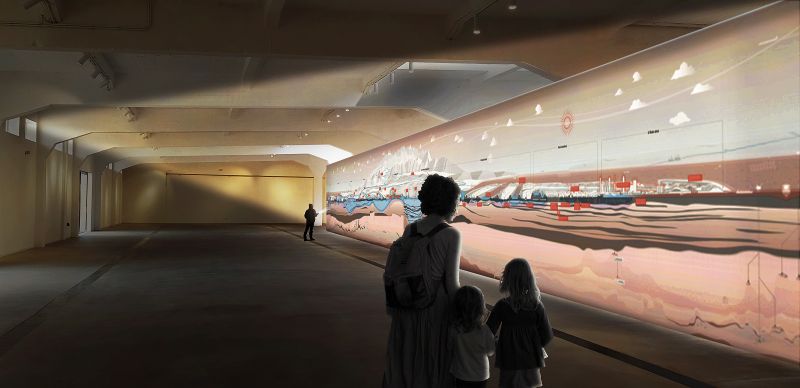In the Dutch delta, climate change is generating completely new problems. More and more often there is too much water, but we are also – and this is really new – now confronted with drought and shortages of fresh water.
For hundreds of years, we’ve worked hard to make our country better at draining water as quickly and efficiently as possible for reasons of safety and agricultural productivity. But now we are suddenly facing a new challenge: how to retain water in order to be able to use it when we need it.

artist impression of the animation of Droogte in de Delta in the Keilezaal
© IABR, SMV
Building blocks for a new freshwater strategy
In the exhibition DOWN TO EARTH: DROUGHT IN THE DELTA, the results of the research by design done by the IABR–Atelier Drought in the Delta illustrate this challenge with an animation of a cross section of the Dutch Delta. Looking in the direction of Germany, France and Belgium, upstream along the Rhine, Meuse and Scheldt, we see the Alps in the distance. In about seven minutes, the animation shows how our delta is currently functioning, what problems have arisen due to climate change and what possible solutions there are.
The aim of the Atelier was to provide building blocks for a new freshwater strategy in conjunction with other transition challenges, such as the energy transition, food production, and urbanization, which always involve increasingly intensive use of the topsoil and subsoil.
Different subsystems, diverse solutions, many opportunities
The Dutch delta consists of a number of subsystems, each with a characteristic soil and water system and its own landscape characteristics. The freshwater shortage therefore manifests itself differently in different places, with numerous consequences and therefore the urgent need to investigate diverse possible solutions.
The pressure on land use is great and the spatial claims of transition tasks in the areas of energy, water, food, and the built environment only add to it. But if we connect these tasks and use them as leverage, there are also many opportunities.
Concrete proposals and a call for action
Drought in the Delta highlights ten subareas. For each subsystem, the animation sketches a picture of the future in which measures to increase the water buffering capacity serve as a lever for other transition tasks. For example, a renewed freshwater system can contribute to robust nature (biodiversity and the reduction of natural fires, for instance), to the energy transition (aquathermia), to the reduction of CO2 emissions (wetting peat meadows) and to sustainable urbanization (water plazas and retention parks).
By showing how we are able to deal with weather extremes, right down to the subsoil, the study points the way to how the freshwater challenge can be used as leverage to attain the comprehensive transformation of our delta, which is actually one large urban landscape. At the same time, an attractive picture of the future of the Netherlands is painted, with a wide variety of landscapes. Something that is certainly possible if we broker good international agreements about the water distribution in the Rhine, Meuse and Scheldt catchment area.
In short, the results of the research by design done by the Atelier are a call for action. We need concrete building blocks for a new national freshwater strategy and, equally important, concrete proposals for solution directions, in order to make it possible for local and regional authorities to work on their own specific tasks, in such a way that they seamlessly fit into the inevitably comprehensive transition of the entire delta.
IABR–Atelier Drought in the Delta
research by design
Studio Marco Vermeulen
Marco Vermeulen (lead designer)
Bram Willemse, Joost van der Waal
production and projectmanagement
IABR
Jolanda van Dinteren, Suzanne Tietema
Johanna Fuhler, Vivian Ammerlaan
director IABR–Ateliers
George Brugmans
IABR initiates and produces the IABR–Ateliers in the Netherlands as a lead partner of the Dutch National Government within the framework of the ARO, the Action Agenda for Spatial Design 2017–2020 of the Ministry of the Interior and Kingdom Relations